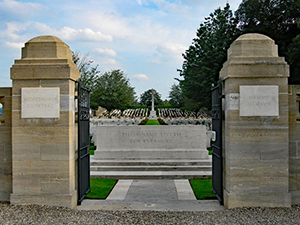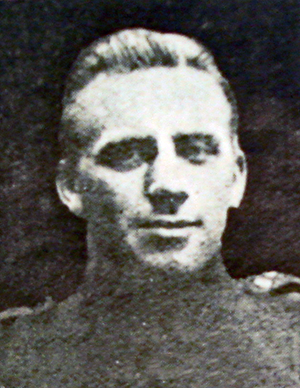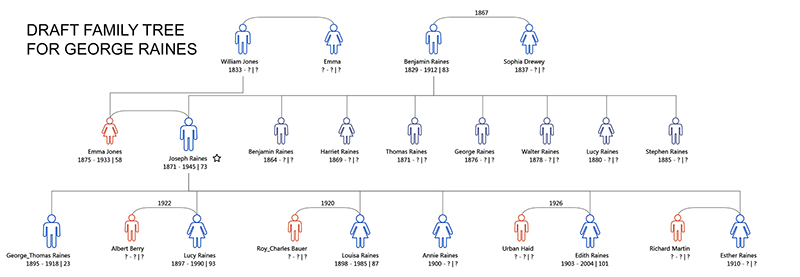First World War Project
George RAINES (of Newnham)
b.11th March 1895 Private, Service Number L/10210 |

"GONE BUT NOT FORGOTTEN"
 George was born to Joseph and Emma (née Jones) Raines from Newnham - Joseph had been both a carter on a farm and latterly a road labourer. George had five younger siblings, all of whom went with their parents to Canada in 1912, leaving George behind. His sisters remained in Canada - Lucy (who married Albert Berry), Louisa (m. Roy Charles Bauer), Annie, Edith (m. Urban Haid) and Esther (m. Richard Martin).
George was born to Joseph and Emma (née Jones) Raines from Newnham - Joseph had been both a carter on a farm and latterly a road labourer. George had five younger siblings, all of whom went with their parents to Canada in 1912, leaving George behind. His sisters remained in Canada - Lucy (who married Albert Berry), Louisa (m. Roy Charles Bauer), Annie, Edith (m. Urban Haid) and Esther (m. Richard Martin).
Military records reveal George as standing 5 feet 5½ inches tall, weighing 153 lbs and with a chest expansion from 37 to 39 inches. He was Fresh complexioned, blue eyes, and light brown hair. Summarised at the time as "good" physical development.
At the time of George's death, his parents were living at 138, Charon Street, Kitchener, Ontario, Canada. George, at the age of 16 in the 1911 Census was a Carter on a Farm - living at Lower Champion Court, Newnham - still with his parents, but he obviously elected to stay in Newnham. The adventurousness of his parents was matched by George's very early enlistment into the Army when the First World War initially broke out.
His parent's generation and those of his grandparents were predominantly Eastling folk, less than one mile from Newnham. Indeed, while George and Lucy were born in Newnham, and Louisa was born in Oare, his youngest two siblings were also born in Eastling. This was a family firmly rooted locally.
In the 1901 Census, Emma's widowed father, William, and brother Stephen, were living with her new family living at Kettle Hill, Eastling at that time. Joseph at this time was a "Carter on Farm", quite possibly Kettle Hill Farm.
George was first buried in Ruebeland Cemetery [Plot N.E., Row 6, Grave 4] before being Concentrated to Niederzwehren Cemetery, Kassel (Cassel), Germany. His parents added "GONE BUT NOT FORGOTTEN" to his headstone.
As George's legatee, his mother, Emma, received £24.50 War Gratuity and personal effects/pay amounting to £66 18s. 7d. [Equivalent to more than £6,000 today]. This figure reflects George's position as a PoW, unable to spend his pay. [See Appendix 2]
He was posthumously awarded the 1914-1915 Star, the British War and Victory medals. [See Appendix 1]
Military Experience of George Raines
George attested at Maidstone on 6th August 1914 at the age of "19 years and 148 days" with a declared preference for The Buffs. He joined the Buffs Depot at Canterbury on 9th August 1914. His total military service amounted to four years and 80 days. However, his active service in the Field was significantly shorter. He landed in France on 23rd February 1915 and was posted "missing" on 3rd May 1915. From that date he was a Prisoner of War, only to die 3 years and five months later just before the close of war. The cause of his death is not found in the official records coming from the German authorities.
Whilst in training at Dover, on 21st January 1915, he was punished (3 days confined to barracks) for "Breaking out of barracks about 7.30 p.m. remaining absent until 10.15 p.m. (45 min)." Witnesses: Sergeant Landon and Corporal Bushell.
At the outbreak of the war, the 2nd/Buffs was stationed at Wellington, Madras. They were quickly drawn back to engage in the European Theatre, leaving Bombay on 16th November for England where it joined the 85th Brigade of the 28th Division. A period of refitting and training was necessary before the 2nd Battalion mobilised for war, landing in Havre on 17th January 1915. They then proceeded to take part in the Second Battle of Ypres, the Battle of Loos.
When George joined his comrades at the Front on 23rd February, the diary reveals the location as LOCRE ("Loker" today), to the south and west of Ypres.
"22nd February 1915: LOCRE: 10.00 am: Orders received to take over part of the trenches occupied by Royal Irish Rifles and South Lancs Regiment that evening.
5.45 pm: The Battalion paraded at LOCRE and moved to KEMMEL. The trenches to be occupied by us were numbered as follows. G2, G3, G4, S4.
10.30 pm: Companies moved out to their trenches being led by guides. Reports showed all taken over correctly. Battalion H.Q. were situated at a farm IRISH HOUSE. All Companies rendered very satisfactory reports during the night with regard to the state of their trenches. Cooking could be carried out in braziers with charcoal and coke, and each section of trench was to be relieved every 24 hours under Regimental arrangements by troops held in support. The parapets were thicker and higher and a good stretch of barbed wire was placed in front of each trench, supports were held in readiness to assist in case of an attack."
This part of the Front remained quiet, allowing for improvements to be made in them, draining them, repairing telephone wires. On 27th February, the Battalion rested at LOCRE. By 23rd March the Battalion was resting in billets at DICKEBUSCH, providing working parties as required. It wasn't until 28th March that the Battalion returned to the trenches to defend ST. ELOI, reserved in VOORMEZELE and Chateau at KRUISTRAATHOEK suffering several casualties. This was almost certainly George's first experience of fighting in the trenches. The position was going to worsen in April 1915.
On 3rd April 1915, 6pm: ST. ELOI heavily bombarded by 6" Howitzers and trench mortars from the mound. No.1 barricade was blown in. Maxim Gun badly damaged: telephone operator buried and killed. 1 Officer wounded; Other Ranks: 4 killed, 13 Wounded.
Relieved by 4th Battalion Royal Fusiliers of the 9th Brigade. Battalion marched back to huts in DICKEBUSCH and then through YPRES to ZONNEBEKE to relieve the 153rd French Regiment.
Actions prior to being taken prisoner - the beginning of gas warfare
From the Battalion War Diary:
"21st April: ST. JEAN: Relieved by 3rd Royal Fusiliers night of 20th/21st when Battalion returned to billets in YPRES, but owing to the town being heavily shelled all troops were moved into the open fields near ST. JEAN, where shelters and dug outs were soon erected. Draft of 63 Men joined.
22nd: 5 p.m.: Sudden sharp outburst of Artillery fire and rattle of musketry from N.W. gradually ceasing and followed a little later by a powerful reek of escaped gas. Half an hour after French troops appear in scattered twos and threes retiring across the open fields from the North and North-West. It was at once apparent that something was wrong, for machine gun and rifle fire sounded within 1,000 yards of ST. JEAN and billets were spattering into the village.
Without any bustle or confusion all the Canadians in billets turned out and fell in.
Two battalions of the 85th Brigade, the 2nd Buffs and 3rd Middlesex and also the 4th Kings Own Royal Lancasters all under Colonel A.D. Geddes. The Buffs likewise immediately stood to arms."
The gap left by the retiring gassed French troops was filled immediately and fell under the orders of the Canadian Division. There followed a period of consolidation and adjustment as the Allies understood that the Germans had employed gas against them.
"28th April: To the great relief of all ranks the battalion received orders from Colonel Geddes to rejoin the 85th Brigade at VERLORENHOEK. Colonel Geddes composite Brigade is now broken up.
9 a.m.: A shell entered the room in the Brigade H.Q. in which Colonel Geddes was sitting. Killed the Colonel and severely wounded his staff officers.
11 a.m.: The battalion made new dug outs in fields near VERLORENHOEK.
8 p.m.: Moved via ZONNEBEKE railway crossing to our old trenches in the GRAFENSTAFEL area: relieved 3rd Royal Fusiliers in Trenches D1 & 2 and D4 & 5. Fusiliers continued to hold D3.
Since 22nd, 3rd Royal Fusiliers had had a very trying time and had lost many men.
29th: A quiet day much to everyone's surprise.
30th: Another quiet day. Enemy occupied with French attack on our left. 2/Lieut Barlshouse brought up draft of 116 men, these were put to the support dugouts.
May 1st: Enemy active in shelling our whole trench line. 8 p.m. Moved draft into new support trench behind wood near D4 & 5.
May 2nd: Very heavy shelling all day to which our artillery were unable to reply. Draft in new support trench had a most trying baptism of fire. Captains L. Howard Smith and H.L. Archer Houblon with draft of 34 men arrived and were moved into trenches D4 and D5. Reinforced by remainder 3rd Royal Fusiliers one company occupying new support trench and remainder in dug outs near Battalion H.Q.
May 3rd: From early dawn enemy commenced mortaring and shelling D4 and 5 and the new support trench in a relentless and determined manner.
7.30 a.m.: Captain Houblon reported many casualties, his parapet blown in at many points and the situation critical. Soon after reports arrive from D1 and D3 that enemy were moving in force over from our right to our left and appeared to be massing behind houses in front of D5.
Enemy continued fierce shelling with crumps, high explosive shrapnel and whiz bangs to which our artillery made little or no reply. It was a most nerve-racking and trying period for all troops concerned. A state of affairs existed which was almost intolerable.
3.30 p.m.: Enemy opened rapid from several batteries of whiz bangs on to the remainder of the parapet of D4 and 5. This bombardment sounded like Machine Gun fire from field guns it was so rapid and incessant. A little later the enemy walked into D5, then being few if any left to resist them.
Captain L. Howard Smith, Lieut G.R. Howe with some 80 men of "C" Company had occupied this trench - this whole party is now missing and it is believed most of them were killed or wounded.
The Germans now occupied the woods behind D5, a movement which made D4 quite untenable - they were held up however by a small party of Buffs under 2/Lieut Backhouse and a company of Royal Fusiliers under Capt. Ford who gallantly held on to the new support trench despite fearsome enfilade fire from heavy howitzers and other artillery.
Capt. Houblon and Liety Sharp and remainder of "D" Company who were still holding D4 were now being enfiladed by Germans from D5 and taken in revers from the wood. Capt. Houblon therefore was compelled to retire along the trench line, a movement which was carried out steadily. The Germans were still pressing forward and soon occupied a portion of the new support trench when it joined D4. Our men and the enemy were now only a few yards apart. Unfortunately the enemy were in great numbers and a far stronger situation. Many of the enemy were shot, especially where they filed out of the wood in front of D.S. In the retirement we also lost heavily.
The two last men in D4 were Company Sergeant Major Post and No.7852 Private F. Campbell both of "C" Company. These two bravely kept the enemy off, while the others got away and were able eventually both to follow under very heavy fire.
Lieut. Sharp was wounded but was able with the survivors of Captain Houblon's party to reach D3 and later to D1 held by Captain Barnard with "A" Company. When the Musketry and machine gun fire opened in the wood, Major Power and Major Johnstone instantly decided to send up their Support Company to the ridge S.W. of the wood with the object of checking the enemy's advance and of reinforcing Capt. Fud's Company in the new Support trench. The exact situation at this time was unknown. On the way up, Major Power was wounded in the chest.
From about 3.45 p.m. to 6 p.m. the enemy flattened, bombarded and searched the ridge with an inferno of artillery fire, but the Royal Fusiliers and a few of the 4th East Yorks stood their ground and the enemy showed no inclination to advance from the wood. Any moment our people hoped to hear an Artillery open, but hoped in vain. If only our guns could have got in to the wood, the enemy must have suffered heavily. As it was the contest was an unequal one. It was our infantry alone against the enemy's infantry in force and a most powerful combination of the enemy's artillery. Fortunately for us the attack of the enemy's infantry lacked grist and determination.
[Addition in margin of the Diary: "The other ranks casualties are most difficult to account for particularly in respect of the 150 men of the two drafts that arrived on 30th April and 1st May respectively, these mens' names were not known. Also many men were buried in the trenches and it was impossible to obtain identity discs. The following figures are approximate, it is certain however that many others have been killed, including the majority of the above-mentioned drafts.
Killed - 67. Wounded - 259. Wounded and missing - 13. Missing - 363.]
Things quieted down towards dusk, the enemy contenting himself with remaining where he was, enabling our retirement which was ordered for the night 3/4th May to be carried out quite steadily with a minimum of loss, all wounded men, spare ammunition and tools being brought away."
The remnant of the battalion moved back to a wood near POPERINGHE where it bivouacked.
Circumstances of the death of George Thomas Raines
Taken as a Prisoner of War in 1915 (declared "Missing" on 3rd May 1915), George Thomas Raines was one of 363 men "missing" after a ferocious German attack over-ran part of the British trench network. We have not been able to account for George during his incarceration so are unable to give the ultimate cause of his death. The German Lists did not contain that information. It is widely reported that many deaths arose from disease, trauma, and starvation. Given the span of time for George Thomas Raines between capture and death, it is unlikely he died from trauma but perhaps died from a weakened condition. The German guards were also suffering starvation and disease as the war unfolded.
[Note: Two Teynham lads from the 2nd Battalion were killed in the chaotic fighting that claimed George's life: 2nd October, George Abraham Hall and 3rd October, Leonard Terry. Both were also witness to the first use of gas in the field.]


 World War 1 Pages
World War 1 Pages